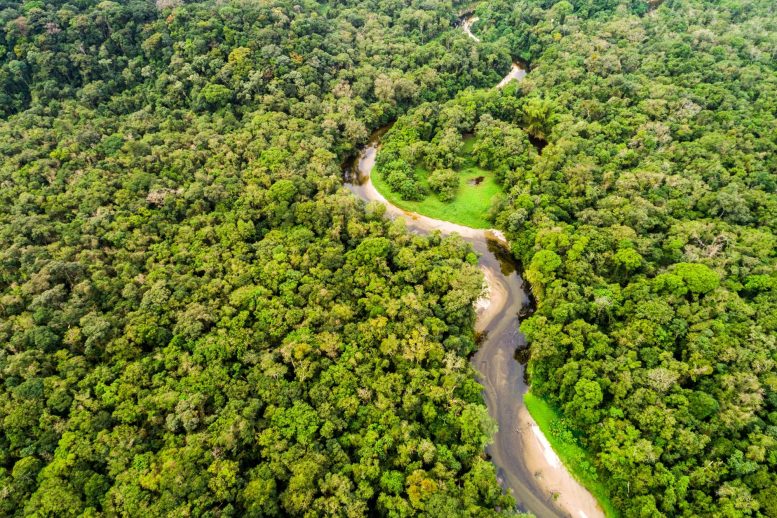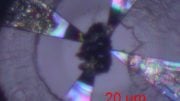
A groundbreaking study by UCL and international scientists has discovered that just 2.2% of tree species account for half of the trees in tropical forests globally. This uniform pattern across diverse regions like Africa, the Amazon, and Southeast Asia suggests a fundamental mechanism shaping these ecosystems.
Scientists have found that a small number of tree species dominate tropical forests worldwide, challenging previous notions about the diversity of these ecosystems.
A major international collaboration of 356 scientists led by UCL researchers has found almost identical patterns of tree diversity across the world’s tropical forests.
The study of over one million trees across 1,568 locations, published today (January 10) in Nature, found that just 2.2% of tree species make up 50% of the total number of trees in tropical forests across Africa, the Amazon, and Southeast Asia. Each continent consists of the same proportion of a few common species and many rare species.
While tropical forests are famous for their diversity, this is the first time that scientists have studied the commonest trees in the world’s tropical forests.
The scientists estimate that just 1,053 species account for half of the planet’s 800 billion tropical forest trees. The other half is comprised of 46,000 tree species. The number of rare species is extreme, with the rarest 39,500 species accounting for just 10% of trees.
Lead author Dr. Declan Cooper (UCL Geography and UCL Centre for Biodiversity and Environment Research) said: “Our findings have profound implications for understanding tropical forests. If we focus on understanding the commonest tree species, we can probably predict how the whole forest will respond to today’s rapid environmental changes. This is especially important because tropical forests contain a tremendous amount of stored carbon, and are a globally important carbon sink.”
He continued: “Identifying the prevalence of the most common species gives scientists a new way of looking at tropical forests. Tracking these common species may provide a new way to characterize these forests and in the future possibly gauge a forest’s health more easily.”
The researchers found strikingly similar patterns in the proportion of tree species that are common, at close to 2.2%, despite the tropical forests of the Amazon, Africa and Southeast Asia each having a unique history and differing contemporary environments.
The Amazon consists of a large region of connected forest, while Southeast Asia is a region of mostly disconnected islands. People only arrived in the Amazon around 20,000 years ago, but people have been living in African and Southeast Asian forests for more than twice that length of time. In terms of the contemporary environment, African forests experience a drier and cooler climate than the other two tropical forest regions.
Given these striking differences, the near-identical patterns of tree diversity suggest that a fundamental mechanism may govern the assembly of tree communities across all the world’s tropical forests. The researchers are not yet able to say what that mechanism might be and it will focus future work on identifying it.
The estimates of common species derive from statistical analyses, which does not provide the names of the common trees. To overcome this, the scientists used a technique known as resampling to estimate which are the most likely names of the common species. Their list of 1,119 tree species names, the first list of common species of the world’s tropical forests, will allow researchers to focus their efforts on understanding the ecology of these species, which in turn can give scientists a short-cut to understand the whole forest.
See table below for a list of the most common tropical tree species.
Most common tropical forest tree species:
| Continent | Scientific name | Local Names |
| Africa | Gilbertiodendron dewevrei | Limbali, otabo, agbabu, ekpagoi-eze |
| Africa | Greenwayodendron suaveolens | Africa Teak, atorewa, ẹ́wáé, nchua, eleku, agudugbu |
| Africa | Anonidium mannii | Junglesop, imido, asumpa, ọ̀ghẹ́dẹ́gbó |
| Africa | Petersianthus macrocarpus | Stinkwood tree; soap tree abalé, tun-tue, pèh, ésiv, kpa |
| Africa | Santiria trimera | adjouaba à racines aériennes, damzin, an-thanjka, kafe, poh, gólógóló. |
| Africa | Strombosia pustulata | itako, afina, poé, mba esogo |
| Africa | Tabernaemontana crassa | Adam’s-apple flower, k-poŋgbo, opuko, patié patié, pete-pete |
| Africa | Staudtia kamerunensis | Niové, ichala, ọbara-okisi, íyìp ókōyò |
| Africa | Strombosiopsis tetrandra | Bwika, Mbazoo |
| Africa | Dichostemma glaucescens | Mangamba, Mongamba |
| Amazonia | Oenocarpus bacaba | Bacaba, Turu Palm |
| Amazonia | Eschweilera coriacea | matamatá |
| Amazonia | Iriartea deltoidea | bombona |
| Amazonia | Pentaclethra macroloba | pracaxi |
| Amazonia | Euterpe oleracea | açaí palm |
| Amazonia | Astrocaryum murumuru | murumuru |
| Amazonia | Geissospermum sericeum | quina-quina branca, pao pereira |
| Amazonia | Eperua falcata | bootlace tree, bi udu, wapa |
| Amazonia | Euterpe precatoria | mountain cabbage; açai, açaizeiro, açaí-do-amazonas, palmiche, wassaï, huasaí, manaca |
| Amazonia | Rinorea racemosa | branquinha |
| Southeast Asia | Shorea multiflora | yellow meranti |
| Southeast Asia | Tristaniopsis merguensis | Hill Tristania |
| Southeast Asia | Cotylelobium melanoxylon | Resak hitam; Khiam khaao; Resak tempurong; Giam tembaga |
| Southeast Asia | Dehaasia caesia | Magasil, Medang |
| Southeast Asia | Streblus ilicifolius | Jungle Holly, Merlimau |
| Southeast Asia | Shorea xanthophylla | seraya kuning barun |
| Southeast Asia | Shorea parvifolia | light red meranti, white lauan |
| Southeast Asia | Elateriospermum tapos | Perah, Buah Perah, Pogoh Nut, Tapos |
| Southeast Asia | Ixonanthes reticulata | Pagar Anak, Ten Men Tree, Inggir Burong, Nyiran Burong |
| Southeast Asia | Gluta oba | Rengas |
Senior author, Professor Simon Lewis (UCL Geography and University of Leeds) said: “We wanted to look at tropical forests in a new way. Focusing on a few hundred common tree species on each continent, rather than the many thousands of species that we know almost nothing about, can open new ways to understand these precious forests. This focus on the commonest species should not take away from the importance of rare species. Rare species need special attention to protect them, but quick and important gains in knowledge will come from a scientific focus on the commonest tree species.”
The researchers assembled forest inventory data from intact tropical forests that hadn’t been affected by logging or fire. In each of 1,568 locations, teams identified and recorded every tree with a trunk greater than 10 centimeters in diameter, in a patch of forest, usually one hectare, which is a square of forest measuring 100 meters on each side.
Professor Lewis has been collecting and collating this data for 20 years. The effort is a collaboration of the largest plot networks across the Amazon (Amazon Tree Diversity Network; RAINFOR), Africa (African Tropical Rainforest Observatory Network, AfriTRON; Central African Plot Network), and Southeast Asia (Slik Diversity Network; T-FORCES), brought together for the first time for the published analysis.
This collaboration across hundreds of researchers, field assistants, and local communities resulted in a total of 1,003,805 trees sampled, which included 8,493 tree species, across 2,048 hectares, equivalent to almost eight square miles of forest. The teams inventoried 1,097 plots in the Amazon totaling 1,434 hectares, 368 plots in Africa totaling 450 hectares, and 103 plots in Southeast Asia totaling 164 hectares.
Reference: “Consistent patterns of common species across tropical tree communities” by Declan L. M. Cooper, Simon L. Lewis, Martin J. P. Sullivan, Paulo I. Prado, Hans ter Steege, Nicolas Barbier, Ferry Slik, Bonaventure Sonké, Corneille E. N. Ewango, Stephen Adu-Bredu, Kofi Affum-Baffoe, Daniel P. P. de Aguiar, Manuel Augusto Ahuite Reategui, Shin-Ichiro Aiba, Bianca Weiss Albuquerque, Francisca Dionízia de Almeida Matos, Alfonso Alonso, Christian A. Amani, Dário Dantas do Amaral, Iêda Leão do Amaral, Ana Andrade, Ires Paula de Andrade Miranda, Ilondea B. Angoboy, Alejandro Araujo-Murakami, Nicolás Castaño Arboleda, Luzmila Arroyo, Peter Ashton, Gerardo A. Aymard C, Cláudia Baider, Timothy R. Baker, Michael Philippe Bessike Balinga, Henrik Balslev, Lindsay F. Banin, Olaf S. Bánki, Chris Baraloto, Edelcilio Marques Barbosa, Flávia Rodrigues Barbosa, Jos Barlow, Jean-Francois Bastin, Hans Beeckman, Serge Begne, Natacha Nssi Bengone, Erika Berenguer, Nicholas Berry, Robert Bitariho, Pascal Boeckx, Jan Bogaert, Bernard Bonyoma, Patrick Boundja, Nils Bourland, Faustin Boyemba Bosela, Fabian Brambach, Roel Brienen, David F. R. P. Burslem, José Luís Camargo, Wegliane Campelo, Angela Cano, Sasha Cárdenas, Dairon Cárdenas López, Rainiellen de Sá Carpanedo, Yrma Andreina Carrero Márquez, Fernanda Antunes Carvalho, Luisa Fernanda Casas, Hernán Castellanos, Carolina V. Castilho, Carlos Cerón, Colin A. Chapman, Jerome Chave, Phourin Chhang, Wanlop Chutipong, George B. Chuyong, Bruno Barçante Ladvocat Cintra, Connie J. Clark, Fernanda Coelho de Souza, James A. Comiskey, David A. Coomes, Fernando Cornejo Valverde, Diego F. Correa, Flávia R. C. Costa, Janaina Barbosa Pedrosa Costa, Pierre Couteron, Heike Culmsee, Aida Cuni-Sanchez, Francisco Dallmeier, Gabriel Damasco, Gilles Dauby, Nállarett Dávila, Hilda Paulette Dávila Doza, Jose Don T. De Alban, Rafael L. de Assis, Charles De Canniere, Thales De Haulleville, Marcelo de Jesus Veiga Carim, Layon O. Demarchi, Kyle G. Dexter, Anthony Di Fiore, Hazimah Haji Mohammad Din, Mathias I. Disney, Brice Yannick Djiofack, Marie-Noël K. Djuikouo, Tran Van Do, Jean-Louis Doucet, Freddie C. Draper, Vincent Droissart, Joost F. Duivenvoorden, Julien Engel, Vittoria Estienne, William Farfan-Rios, Sophie Fauset, Kenneth J. Feeley, Yuri Oliveira Feitosa, Ted R. Feldpausch, Cid Ferreira, Joice Ferreira, Leandro Valle Ferreira, Christine D. Fletcher, Bernardo Monteiro Flores, Alusine Fofanah, Ernest G. Foli, Émile Fonty, Gabriella M. Fredriksson, Alfredo Fuentes, David Galbraith, George Pepe Gallardo Gonzales, Karina Garcia-Cabrera, Roosevelt García-Villacorta, Vitor H. F. Gomes, Ricardo Zárate Gómez, Therany Gonzales, Rogerio Gribel, Marcelino Carneiro Guedes, Juan Ernesto Guevara, Khalid Rehman Hakeem, Jefferson S. Hall, Keith C. Hamer, Alan C. Hamilton, David J. Harris, Rhett D. Harrison, Terese B. Hart, Andy Hector, Terry W. Henkel, John Herbohn, Mireille B. N. Hockemba, Bruce Hoffman, Milena Holmgren, Euridice N. Honorio Coronado, Isau Huamantupa-Chuquimaco, Wannes Hubau, Nobuo Imai, Mariana Victória Irume, Patrick A. Jansen, Kathryn J. Jeffery, Eliana M. Jimenez, Tommaso Jucker, André Braga Junqueira, Michelle Kalamandeen, Narcisse G. Kamdem, Kuswata Kartawinata, Emmanuel Kasongo Yakusu, John M. Katembo, Elizabeth Kearsley, David Kenfack, Michael Kessler, Thiri Toe Khaing, Timothy J. Killeen, Kanehiro Kitayama, Bente Klitgaard, Nicolas Labrière, Yves Laumonier, Susan G. W. Laurance, William F. Laurance, Félix Laurent, Tinh Cong Le, Trai Trong Le, Miguel E. Leal, Evlyn Márcia Leão de Moraes Novo, Aurora Levesley, Moses B. Libalah, Juan Carlos Licona, Diógenes de Andrade Lima Filho, Jeremy A. Lindsell, Aline Lopes, Maria Aparecida Lopes, Jon C. Lovett, Richard Lowe, José Rafael Lozada, Xinghui Lu, Nestor K. Luambua, Bruno Garcia Luize, Paul Maas, José Leonardo Lima Magalhães, William E. Magnusson, Ni Putu Diana Mahayani, Jean-Remy Makana, Yadvinder Malhi, Lorena Maniguaje Rincón, Asyraf Mansor, Angelo Gilberto Manzatto, Beatriz S. Marimon, Ben Hur Marimon-Junior, Andrew R Marshall, Maria Pires Martins, Faustin M. Mbayu, Marcelo Brilhante de Medeiros, Italo Mesones, Faizah Metali, Vianet Mihindou, Jerome Millet, William Milliken, Hugo F. Mogollón, Jean-François Molino, Mohd. Nizam Mohd. Said, Abel Monteagudo Mendoza, Juan Carlos Montero, Sam Moore, Bonifacio Mostacedo, Linder Felipe Mozombite Pinto, Sharif Ahmed Mukul, Pantaleo K. T. Munishi, Hidetoshi Nagamasu, Henrique Eduardo Mendonça Nascimento, Marcelo Trindade Nascimento, David Neill, Reuben Nilus, Janaína Costa Noronha, Laurent Nsenga, Percy Núñez Vargas, Lucas Ojo, Alexandre A. Oliveira, Edmar Almeida de Oliveira, Fidèle Evouna Ondo, Walter Palacios Cuenca, Susamar Pansini, Marcelo Petratti Pansonato, Marcos Ríos Paredes, Ekananda Paudel, Daniela Pauletto, Richard G. Pearson, José Luis Marcelo Pena, R. Toby Pennington, Carlos A. Peres, Andrea Permana, Pascal Petronelli, Maria Cristina Peñuela Mora, Juan Fernando Phillips, Oliver L. Phillips, Georgia Pickavance, Maria Teresa Fernandez Piedade, Nigel C. A. Pitman, Pierre Ploton, Andreas Popelier, John R. Poulsen, Adriana Prieto, Richard B. Primack, Hari Priyadi, Lan Qie, Adriano Costa Quaresma, Helder Lima de Queiroz, Hirma Ramirez-Angulo, José Ferreira Ramos, Neidiane Farias Costa Reis, Jan Reitsma, Juan David Cardenas Revilla, Terhi Riutta, Gonzalo Rivas-Torres, Iyan Robiansyah, Maira Rocha, Domingos de Jesus Rodrigues, M. Elizabeth Rodriguez-Ronderos, Francesco Rovero, Andes H. Rozak, Agustín Rudas, Ervan Rutishauser, Daniel Sabatier, Le Bienfaiteur Sagang, Adeilza Felipe Sampaio, Ismayadi Samsoedin, Manichanh Satdichanh, Juliana Schietti, Jochen Schöngart, Veridiana Vizoni Scudeller, Naret Seuaturien, Douglas Sheil, Rodrigo Sierra, Miles R. Silman, Thiago Sanna Freire Silva, José Renan da Silva Guimarães, Murielle Simo-Droissart, Marcelo Fragomeni Simon, Plinio Sist, Thaiane R. Sousa, Emanuelle de Sousa Farias, Luiz de Souza Coelho, Dominick V. Spracklen, Suzanne M. Stas, Robert Steinmetz, Pablo R. Stevenson, Juliana Stropp, Rahayu S. Sukri, Terry C. H. Sunderland, Eizi Suzuki, Michael D. Swaine, Jianwei Tang, James Taplin, David M. Taylor, J. Sebastián Tello, John Terborgh, Nicolas Texier, Ida Theilade, Duncan W. Thomas, Raquel Thomas, Sean C. Thomas, Milton Tirado, Benjamin Toirambe, José Julio de Toledo, Kyle W. Tomlinson, Armando Torres-Lezama, Hieu Dang Tran, John Tshibamba Mukendi, Roven D. Tumaneng, Maria Natalia Umaña, Peter M. Umunay, Ligia Estela Urrego Giraldo, Elvis H. Valderrama Sandoval, Luis Valenzuela Gamarra, Tinde R. Van Andel, Martin van de Bult, Jaqueline van de Pol, Geertje van der Heijden, Rodolfo Vasquez, César I. A. Vela, Eduardo Martins Venticinque, Hans Verbeeck, Rizza Karen A. Veridiano, Alberto Vicentini, Ima Célia Guimarães Vieira, Emilio Vilanova Torre, Daniel Villarroel, Boris Eduardo Villa Zegarra, Jason Vleminckx, Patricio von Hildebrand, Vincent Antoine Vos, Corine Vriesendorp, Edward L. Webb, Lee J. T. White, Serge Wich, Florian Wittmann, Roderick Zagt, Runguo Zang, Charles Eugene Zartman, Lise Zemagho, Egleé L. Zent and Stanford Zent, 10 January 2024, Nature.
DOI: 10.1038/s41586-023-06820-z
This research was supported by the Natural Environmental Research Council.









Has there been any correlation found between these findings and the forest management practices of prehistoric peoples? Is that why these spp. are more prevalent?